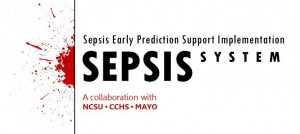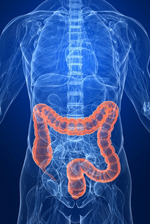Research
User choice model for colorectal cancer screening compliance and long-term outcomes
Predicting health and economic outcomes associated with smoking cessation interventions
Comparing methods of modeling patient choices and behaviors
Stochastic sequential assignment of spontaneous volunteers in post-disaster environments
Simulating the complex interaction between breast cancer and diabetes
Real-time ambulance redeployment problem with workload restrictions
Sepsis Early Prediction Support Implementation System
 Sepsis, defined as infection plus systemic manifestations of infection, is the greatest in-hospital cause of mortality and source of expense. This is due, in part, to difficulties in diagnosis and delayed treatment. Early diagnostic and data-driven response to sepsis and sepsis induced physiological deterioration has the potential to impact the patients’ health trajectory. The goal of this research is to overcome these barriers by integrating electronic health records (EHR) and clinical expertise to provide an evidence-based framework to diagnose and accurately risk-stratify patients within the sepsis spectrum, and develop and validate intervention policies that inform sepsis treatment decisions.
Sepsis, defined as infection plus systemic manifestations of infection, is the greatest in-hospital cause of mortality and source of expense. This is due, in part, to difficulties in diagnosis and delayed treatment. Early diagnostic and data-driven response to sepsis and sepsis induced physiological deterioration has the potential to impact the patients’ health trajectory. The goal of this research is to overcome these barriers by integrating electronic health records (EHR) and clinical expertise to provide an evidence-based framework to diagnose and accurately risk-stratify patients within the sepsis spectrum, and develop and validate intervention policies that inform sepsis treatment decisions.
User choice model for colorectal cancer screening compliance and long-term outcomes
 There has been much work in the simulation community to create detailed models of colon cancer disease progression. In parallel, there has been extensive research done in the medical community performing observational studies and designing campaigns and interventions that effectively change individuals’ cancer screening behavior. Leveraging the work of both communities, we build a detailed model of individuals’ choice and response to public health type interventions based on clinical, observational data to create a validated model of colon cancer progression. This enables us to estimate the cost-effectiveness of these interventions in terms of long-term health outcomes when applied to a population of individuals. Our model was developed though collaboration between NCSU Industrial and Systems Engineering and the School of Public Health at the University of North Carolina at Chapel Hill.
There has been much work in the simulation community to create detailed models of colon cancer disease progression. In parallel, there has been extensive research done in the medical community performing observational studies and designing campaigns and interventions that effectively change individuals’ cancer screening behavior. Leveraging the work of both communities, we build a detailed model of individuals’ choice and response to public health type interventions based on clinical, observational data to create a validated model of colon cancer progression. This enables us to estimate the cost-effectiveness of these interventions in terms of long-term health outcomes when applied to a population of individuals. Our model was developed though collaboration between NCSU Industrial and Systems Engineering and the School of Public Health at the University of North Carolina at Chapel Hill.
Predicting health and economic outcomes associated with smoking cessation interventions
 Understanding the complex dynamics of the smoking cessation process is an important health and social-economic issue. This will not only help the smokers themselves to quit, but it will also help doctors design better treatments and help policy makers make more accurate predictions and raise more effective campaigns. As the first step of this research, we utilized the Markov process and simulation methods to build a base model and simulate possible scenarios in order to see whether or not the 2020 healthy people target can be achieved.
Understanding the complex dynamics of the smoking cessation process is an important health and social-economic issue. This will not only help the smokers themselves to quit, but it will also help doctors design better treatments and help policy makers make more accurate predictions and raise more effective campaigns. As the first step of this research, we utilized the Markov process and simulation methods to build a base model and simulate possible scenarios in order to see whether or not the 2020 healthy people target can be achieved.
Comparing methods of modeling patient choices and behaviors
 Modeling health systems and disease progression provides critical insights into the impacts of potential health interventions and policy changes. A challenging aspect of this process is capturing heterogeneity in patient behavior and decision making. Accounting for these differences between individuals contributes to more robust and accurate models and results. In this research, we explore different methods of modeling patient choice and compare their performance in different health contexts. Initial work focuses on treatment selection in smoking cessation, as well as compliance and mode choices regarding colorectal cancer screening.
Modeling health systems and disease progression provides critical insights into the impacts of potential health interventions and policy changes. A challenging aspect of this process is capturing heterogeneity in patient behavior and decision making. Accounting for these differences between individuals contributes to more robust and accurate models and results. In this research, we explore different methods of modeling patient choice and compare their performance in different health contexts. Initial work focuses on treatment selection in smoking cessation, as well as compliance and mode choices regarding colorectal cancer screening.
Stochastic sequential assignment of spontaneous volunteers in post-disaster environments
 Communities all over the world have to grapple with the immense and complicated problem that is emergency logistics. Part of the difficulty with this issue is the management of the large influx of people who flock to affected areas to help during an emergency. These volunteers have the ability to contribute in important ways, but using them effectively is a challenge. Organizers do not know how many such volunteers will arrive, what skills they possess, or how long they will stay. This results in a stochastic sequential assignment problem where the servers both arrive and depart randomly. The goal with this research is to develop a model that will optimally assign these volunteers to specific tasks as they arrive within demand zones.
Communities all over the world have to grapple with the immense and complicated problem that is emergency logistics. Part of the difficulty with this issue is the management of the large influx of people who flock to affected areas to help during an emergency. These volunteers have the ability to contribute in important ways, but using them effectively is a challenge. Organizers do not know how many such volunteers will arrive, what skills they possess, or how long they will stay. This results in a stochastic sequential assignment problem where the servers both arrive and depart randomly. The goal with this research is to develop a model that will optimally assign these volunteers to specific tasks as they arrive within demand zones.
Simulating the complex interaction between breast cancer and diabetes
 In 2010, over 200,000 women in the United States were diagnosed with invasive breast cancer, and an estimated 17% of those women died from the disease, according to the Centers for Disease Control and Prevention (CDC). Also in 2010, the CDC reported that 12.6 million women have diabetes, the seventh leading cause of death in the U.S. Although we know much about these prevalent diseases individually, little research has been conducted regarding the interaction between breast cancer and diabetes. In this research, we build a simulation model that explores this complex relationship. Initially, we assess the prognosis for women who are diagnosed with diabetes considering their breast cancer risk. In the future, we plan to investigate optimal treatment regimens for women with both diseases.
In 2010, over 200,000 women in the United States were diagnosed with invasive breast cancer, and an estimated 17% of those women died from the disease, according to the Centers for Disease Control and Prevention (CDC). Also in 2010, the CDC reported that 12.6 million women have diabetes, the seventh leading cause of death in the U.S. Although we know much about these prevalent diseases individually, little research has been conducted regarding the interaction between breast cancer and diabetes. In this research, we build a simulation model that explores this complex relationship. Initially, we assess the prognosis for women who are diagnosed with diabetes considering their breast cancer risk. In the future, we plan to investigate optimal treatment regimens for women with both diseases.
Real-time ambulance redeployment problem with workload restrictions
 Adequately increasing service coverage is one of the main challenges for emergency medical service (EMS) managers. Ambulance redeployment is one strategy to potentially help to increase coverage when some ambulances become unavailable. However, relocating may not always be possible and/or practical due to EMS professionals’ workload restrictions. Excess repositioning movements can yield undesirable fatigue and back pain for providers. Hence, the EMS dispatcher is faced with two main issues with respect to redeployment decisions: when relocation should occur and what ambulance(s) should move. We have developed a linear binary model for dynamically relocating idle available ambulances assuming that the closest ambulance will be dispatched to an incoming call. Workload considerations imposed with regard to dynamic redeployment are handled with a constraint in the mathematical formulation. We are currently simulating the dynamic process over a real-data set to evaluate the model performance in more detail. Furthermore we are working on a two-stage stochastic programming to deal with maximizing expected coverage while restricting provider workloads.
Adequately increasing service coverage is one of the main challenges for emergency medical service (EMS) managers. Ambulance redeployment is one strategy to potentially help to increase coverage when some ambulances become unavailable. However, relocating may not always be possible and/or practical due to EMS professionals’ workload restrictions. Excess repositioning movements can yield undesirable fatigue and back pain for providers. Hence, the EMS dispatcher is faced with two main issues with respect to redeployment decisions: when relocation should occur and what ambulance(s) should move. We have developed a linear binary model for dynamically relocating idle available ambulances assuming that the closest ambulance will be dispatched to an incoming call. Workload considerations imposed with regard to dynamic redeployment are handled with a constraint in the mathematical formulation. We are currently simulating the dynamic process over a real-data set to evaluate the model performance in more detail. Furthermore we are working on a two-stage stochastic programming to deal with maximizing expected coverage while restricting provider workloads.
